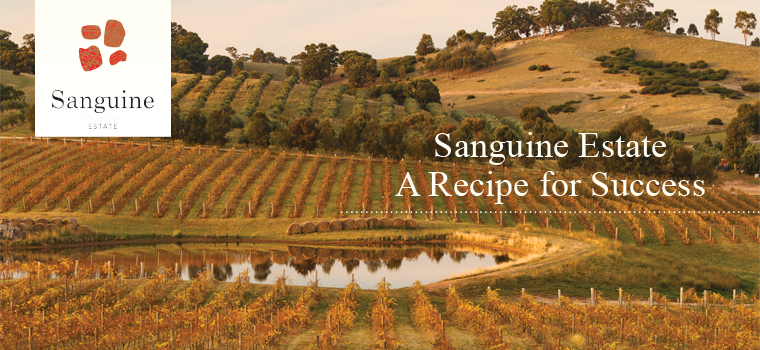A Recipe for Success
“Whilst Sanguine is a comparatively new story, the family do have some important links to the early pioneers of Victorian viticulture.”
CLIVE HARTLEY
WHEN you get a winery owner that has acute business acumen and a passion for wine you have a recipe for success. Add to that the ingredient of an extended family for support you have a business model that will endure for multi-generations. That is the case with Sanguine Estate and the Hunter family. After establishing his own successful international business in the 90’s Tony was able to pursue his passion in wine and love of the Heathcote region of Victoria. “I always loved Heathcote Shiraz and the wines from Jasper Hill and Seppelts Mount Ida and when a property became available between these two vineyards I snapped up the opportunity of purchasing it,” Tony recalls. The Hunter’s story is a classic Australian family tale. Once Tony and his wife Linda established the vineyard in 1996 and increased plantings over a 5 year period, what was a small hobby vineyard turned into a much more demanding operation so son Mark took up his parents offer to became the full time vineyard manager in 2000 and the winemaking role in 2004. Their daughter Jodi joined the team in 2002 eventually taking over the Chief Executive Officer role from her father by 2005. The business now includes daughter-in-law Melissa as Chief Financial Officer and son-in-law Brett Marsh as advisor to the family business. With five grandchildren the future seems secured.
Whilst Sanguine is a comparatively new story, the family do have some important links to the early pioneers of Victorian viticulture. Tony’s Great Grandfather, Pietro D’Orsa was a Swiss Italian migrant that planted vines in Maldon in Central Victoria, just under an hours drive from Sanguine Estate. The family have taken cuttings from some of the vines that have survived to keep the link alive.
Heathcote’s reputation sits firmly in the soils of the region. These ancient red Cambrian soils are found along two faultlines that are around 500 million years old. The soils have good water retention, handy in drought years. The 70 acres of vines at Sanguine Estate sit in the central area of Heathcote, just north of the township, and is wedged between Mount Ida and She Oak Hill. Deep clay loam filed with decaying Cambrian rock takes up the bulk of the vineyards but they also have other soil types that provide blending opportunities. “Wines from Cambrian soils display a ripe plum and graphite earthiness. However, I get more complexity into wines from our different soils. For example, we have vines planted on medium red clay over soapstone. I tend to get blueberry fruits and more dried herbs from these soils,” comments Mark.
One of the keys to making fine wine is processing the fruit in small batches and keeping the yields low. Yields are up and down depending on the season but fluctuate between a lean 1 to 2 tonne per acre. They have recently gone organic which again may affect future yields.
Using 16 small open fermenters allows Mark to make plenty of batches and allows experimentation including whole bunch. Some ferments use 30% whole bunch placed either on top or on bottom of the fermenter. “I haven’t worked out if one is better than the other! Bottom gives me structure, complexity and texture, whilst whole bunches on top gives more aromatic fruit.” Blending is where the fun begins, and a table of up to 90 barrel samples are assembled to craft into three wines. All Sanguine reds rely on wild yeast, minimal sulphur levels and the winery is designed to allow for gravity flow, reducing the need to pump wines.
Sanguine Progeny Shiraz 2019 is their most vibrant, punchy fruit-driven wine with aromatic blueberry, black cherry and violet notes. On the palate it has smooth tannins, well-balanced and has good length. The wine sees around 10% new oak.
Sanguine Inception Shiraz 2019 was formally called their Estate wine. It also has a strong black fruit profile displaying black cherry and blackberry as well as floral violets and a touch of earthiness on the palate, some firm but ripe tannins, giving the wine structure and savoury oak notes as well as licorice, supporting the core of black fruit. The finish is long. Matured in French oak (30% new), Mark has dropped the toasting levels of barrels from heavy to medium and calls upon a number of cooperages, although he does like Vicard at the moment. They use infra-red technology to select staves on their tannin potential and provide a more scientific approach to barrel manufacturing.
The Sanguine D’Orsa Reserve Shiraz 2018 has just been released and sees up to 70% new oak and is a selection of the best barrels. The nose displays opulent vanilla, cedar oak, blackberry and blueberries. Built to age the wine is full bodied, rich, intense and powerful wine with dry savoury tannins and a long finish.
Looking to the future, and the possible effects of climate change; as well as consumer trends, Mark has extended the plantings beyond shiraz.
“We planted tempranillo 15 years ago. That was after viticulturist Richard Smart identified the Heathcote region was similar to Rioja with a warm temperature but cool nights,” explains Mark.
Their 2019 Tempranillo is savoury, herbal, rather than fruit driven ‘cherry-cola’ in style and has some nice tannins. In addition, they have gone with the families Italian roots and planted Nebbiolo and lagrein as well as verdejo and bush vine grenache. It will give them a balanced portfolio to attract new customers and avoid having ‘all their eggs in one basket’.
Looking after your customers is paramount at Sanguine and so they have developed a couple of unique experiences for their growing wine club members. Besides the wine club dinners and their Music Festival in October they have an annual Wine Club Shiraz blending session. Here members get to blend a wine from 4 different wine barrel samples (a whole bunch, a shiraz viognier, a new oak and a traditional Cambrian Heathcote wine). Put into teams it is a competition on who can make the best blend. The winning teams blend is then sent into production of around 100 cases and all participants get their name on the back label and receive six bottles of the wine.
At the pinnacle is their Lifestyle Club where members can adopt a row of vines and can choose to be fully involved with picking and fermenting, then choosing the quality of barrel to mature their wine. They get their name on the row of vines, a plaque on their barrel and their name on the label of the final wine. Once bottled they walk away with around 23 dozen of their own private label shiraz that typically achieves scores of 94 to 96/100 from wine judges.





